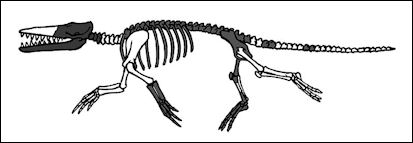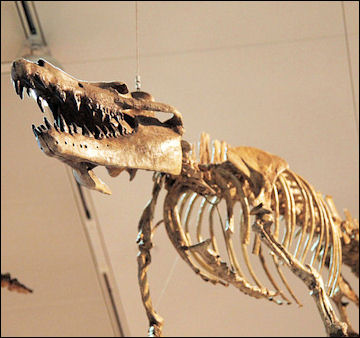Home | Category: Baleen Whales (Blue, Humpback and Right Whales) / Toothed Whales (Orcas, Sperm and Beaked Whales)
EARLY HISTORY OF WHALE

Pakicetus, early ancestor of whales Scientists believe the first cetaceans (whales, dolphins and porpoises) evolved from mammals that lived on land some 55 million years ago, about 10 million years after an asteroid struck just off what is now Mexico's Yucatan peninsula, wiping out most life on Earth, including the dinosaurs. As evidence of their ancient terrestrial past many species of modern whales have tiny bones that are remnants of their hind legs, buried deep in their bodies. Some have a few bristles near their blowholes, reminders that ancestors were once covered in fur.
[Source: Reuters]
Zoe Cormier wrote for BBC Earth: When the ancestors of all dolphins and whales moved from the land into the sea, almost all aspects of their anatomy changed drastically to adapt to their new world: their eyes shrank, their front limbs morphed into flippers, while their hind legs merged into fins. Body hair vanished, no longer helpful for retaining heat, and in its place body fat swelled into thick outer shells of blubber to allow whales to maintain their body temperature even in the coldest waters of the world.
Fossils of 40-million-year-old whales with fingers have been found in Egypt. By this time ancient whales had lost their fur but retained four fingered limbs. They resembled a cross between a seal and a crocodile. Some species had flukes. Some had tails. Over time early whales: 1) lost use of their outer ears and began receiving waterborne sound in their jawbones; 2) their hind limbs grew smaller and smaller; 3) their front legs developed into flippers; 4) their nostrils migrated from their nose to the top of their heads; and they began giving birth to young at sea. Baleen whales began branching off from the toothed whale family about 25 million years. The “Aetiocetus”, a proto baleen whale that lived between 24 and 6 millions years ago, had teeth but showed signs of developing baleen plates from skin tissue on its upper jaws. Bowheads and right whales first appeared about 22 million years ago.
Scientists led by Alistair Evans of Australia’s Monash University, who studied fossil records, worked out that it took 3 million generation for a dolphin-size aquatic mammals to evolve into a blue whales. By comparison sheep-size mammals needed 1.6 million generations to evolve into elephants (or 5 million generations for rabbit-size mammals, 24 million generations form mouse-size mammals. Getting bigger is not just about bones and muscles enlarging; hearts and eyes have to be re-engineered and diet and metabolism change. Whales grew twice as fast as land animals perhaps because water supports added mass better. [Source: National Geographic]
A 25-million-year-old fossil skull, found in Australia and kept at the Museum Victoria, shows that the ancestors of baleen whales were not gentle giants. This ancient whale had teeth and was 3.5 meters long and may have attacked sharks. Megalodons, the infamous giant sharks that lived 23 million to 3.6 million years, are thought to have preyed regularly on baleen whales and other cetaceans. The evidence for this comes from megalodon tooth marks found on prehistoric whale bones.
Related Articles: CATEGORIES: BALEEN WHALES (BLUE, HUMPBACK AND RIGHT WHALES) ioa.factsanddetails.com ; TOOTHED WHALES (ORCAS, SPERM AND BEAKED WHALES) ioa.factsanddetails.com; Articles: TOOTHED WHALES: SWIMMING, ECHOLOCATION AND MELON-HEADS ioa.factsanddetails.com; WHALES: CHARACTERISTICS, ANATOMY, BLOWHOLES, SIZE ioa.factsanddetails.com ; WHALE BEHAVIOR, FEEDING, MATING ioa.factsanddetails.com ; WHALE COMMUNICATION AND SENSES ioa.factsanddetails.com ; WHALING: HISTORY, TECHNIQUES ioa.factsanddetails.com ; ENDANGERED WHALES AND HUMANS ioa.factsanddetails.com ; BLUE WHALES: CHARACTERISTICS, SIZE, HISTORY, RANGE AND BIG HEART ioa.factsanddetails.com ; HUMPBACK WHALES: CHARACTERISTICS, FEEDING AND REPRODUCTION ioa.factsanddetails.com
Websites and Resources: Animal Diversity Web (ADW) animaldiversity.org; National Oceanic and Atmospheric Administration (NOAA) noaa.gov; Fishbase fishbase.se; Encyclopedia of Life eol.org; Smithsonian Oceans Portal ocean.si.edu/ocean-life-ecosystems ; Monterey Bay Aquarium montereybayaquarium.org ; MarineBio marinebio.org/oceans/creatures
How Whales Became So Big
.
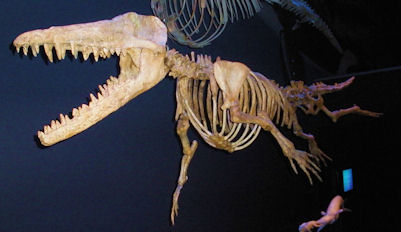
Ambulocetus natans Whales achieved their enormous size relatively recently in evolutionary terms. Elephant-size rhinoceroses, sloths and armadillos existed 35 million years ago. At that time the ancestors of today's giant whales were still pretty small. "It is only since around the beginning of the so-called ice ages that whales have not just evolved to be huge, but titanic in size," Erich M.G. Fitzgerald, a vertebrate paleontologist at Museum Victoria in Australia, said. "Most baleen whales that ever lived were little fellows compared to their modern descendants." [Source: Ben Guarino, Washington Post, May, 27, 2017]
To Nicholas D. Pyenson, an expert in the paleobiology of marine mammals at the Smithsonian's National Museum of Natural History. and other paleontologists, what exactly jump-started the age of aquatic giants remained a mystery. The Washington Post reported: Relying on the extensive collection of fossil whale skulls at the Smithsonian, Pyenson and his colleagues tracked the evolution of baleen whale size. From the skull sizes, the scientists could estimate the body lengths of about 60 species of modern and extinct whales.
Fossils of the first baleen whales appeared about 25 to 20 million years ago. For millions of years afterward, most baleen whales remained about 4.5 meters long. But 3 million years in the past, the scientists reported in May 2017 in the Proceedings of the Royal Society B, baleen whales underwent a dramatic size shift. The smallest baleen whales vanished. The others grew to double or triple the size. Paleobiologist Jorge Velez-Juarbe, a marine mammal curator at the Natural History Museum of Los Angeles County said that experts previously proposed baleen whales grew large as a way to avoid being eaten. But baleen whales didn't outgrow such carnivores until millions of years after predatory sperm whales appeared in the fossil record.
In the 2017 study, Pyenson and his co-authors note that shoreline ecosystems changed about 3 million years ago, around the same time that baleen whales got huge. First, seasonal windy upwellings began to kick up nutrients along the coast; later, glacial runoff added to the richness of these pockets. The net results were souped-up marine ecosystems where whales could feast. It was not that the ocean necessarily had more krill or other whale food. But the food was more densely packed. Pyenson likened the seasonal upwellings to a bag of marbles dumped in a corner of a room, rather than the balls careening across the floor. When the marbles are clustered, it's easier to hoover them up in a single go instead of plucking the marbles one by one.
For suspension feeders such as baleen whales, "the bigger you get, the more efficient you are", Pyenson said. "It maximises the return on density of prey." "A large size allows them to take a giant bite," Velez-Juarbe said in an email, "as well as makes it easier to migrate between areas where food is concentrated." Because the increased marine productivity changed with the seasons, the giants would have to swim vast distances to find new pockets. Gigantism may have allowed large baleen whales to outcompete their smaller cousins.
Earliest Ancestors of Whales
Ambulocetus Fossils of a 51-million-year-old whales that could actually walk were found in the Himalayan foothills in Pakistan in 1981. This creature, called “Pakicetus”, was a relatively small, furry, four-legged animal that looked like an otter with a furry crocodilian head. Fossils of a 49-million-year-old whale, called “Ambulocetis natans”, were found in Pakistan in 1994. It resembled “ Pakicetus” but was larger and had splayed legs.[Source: Douglas Chadwick, National Geographic, November 2001]
Transitional fossils are ones that show evolution from one group to another. Once called missing links they have ancestral features of the older species as well as novel traits of the descendant. Pakicetus is regarded as a transition fossil between land animals and whales: it could move on land but was adapted for life in the sea, with paddlelike forelimbs, ears able to hear underwater and nostrils receded towards a blowhole position. [Source: Newsweek, July 2, 2007]
There is some debate about which terrestrial mammals are closest relatives of whales. It was originally thought that whales evolved from doglike ungulates called mesonychids that lived around 50 millions a year because their jaw bones resembled those of whales. This theory has large been discarded.
These days, most scientist believe that are artiodactyls — even-toed mammals such as deer, sheep, bison, pigs, camels and cattle — are the closest relatives of whale. Artiodactyl-like ankle bones found in ancient whales are offered as proof of this theory. Further evidence includes the fact that whales and artiodactyls have multi-chamber stomachs and similar patterns of folding in their cortexes. Moreover, mother-and-calf behavior of whales is similar to that of moose and caribou and their mating behavior is similar to big horn sheep.
Whales and Hippos
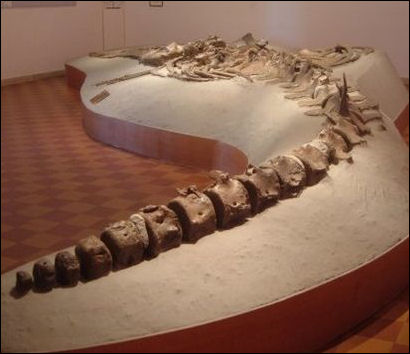
Balenottera di Castelfiorentino Many scientists consider hippopotami, which are not artiodactyls but arose from them, as the closest relatives of whales. Genetic studies indicate that the closest land cousins of whales are hippopotami while seals are related to dogs and manatees and dugongs are most closely related to elephants.
Since the hippo theory has to come to light scientist have found that hippos and whales have certain anatomical similarities such as the lack of scrotums, body hair and sebaceous glands and similarity in internal organ such as lungs.
Some scientist believe that whales evolved from a primitive artiodactyl called anthracotheres. It was a small creature that looked a bit like a hippopotamus and had four hoofs on each foot as hippos do today. They were abundant throughout Eurasia in the early mammal age. Some marsh-dwelling species could have evolved into early whales.
The oldest hippo fossils date to 16 million years ago. Scientists think that they and whales had a common water-loving ancestor that lived 50 million to 60 million years ago. From it evolved early cetaceans, which eventually adapted to the water full time, and early piglike anthracotheres. Anthracotheres flourished, forming 37 distinct genera across the world before dying out leaving just one descendant 2.5 millions year ago — the hippopotamus.
43-Million-Year-Old Four-Legged Whale with a Jackal-Like Head
In August, 2021, scientists in Egypt announced they had discovered a 43-million-year-old fossil of a four-legged whale species that both walked on land and swam in the water. It weighed around 590 kilograms (1,300 pounds) and had a head shaped like a jackal's, and a powerful jaw. The finding offers clues as to how early whales transitioned from being land dwellers to the sea creatures they are today, according to the findings published in the peer-reviewed journal Proceedings of the Royal Society B. [Source: Matthew Loh, Business Insider, August 26, 2021]
Business Insider reported: “Named "Phiomicetus anubis," the newly-discovered species is part of a group of semiaquatic whales called Protocetids, which existed in the Eocene period, which was 56 million to 33.9 million years ago, per the report. Because they are amphibious, Protocetids represent a unique stage in whale evolution that still largely remains a mystery to researchers.
“The Phiomectus anubis had an estimated length of 3.5 meters (10 feet) had a head shaped like a jackal's, and had a powerful jaw that gave it a "raptorial feeding style," according to the study. Its skull was one of the main reasons why the research team named it after the Egyptian god of death Anubis, Abdullah Gohar, the lead author of the paper, told Insider. "We discovered how fierce and deadly its powerful jaws are capable of tearing a wide range of prey ... this whale was a god of death to most of the animals that lived in its area," he said. The fossil came from the Fayum Depression in Egypt's Western Desert, which was once an undersea region, where many other Protocetids have been discovered since German paleontologist Eberhard Fraas unearthed the first one in 1904. Researchers studied the fossil at the Mansoura University Vertebrate Paleontology Center, in the lab of co-author and center founder Hesham Sallam.
Basilosauruses
In 2009, Philip Gingerich, a vertebrate paleontologist at the University of Michigan, unearthed the creature, called Basilosaurus, at a place in the Egyptian desert known as Wadi Hitan. The sinuous 16.5-meter (50-foot) -long beast had gaping jaws and jagged teeth. Gingerich found the creature's 20-centimter (8-inch) leg bone among fossil shark teeth, sea urchin spines, and the bones of giant catfish. He told National Geographic "It isn't every day that you see a whale's leg.”
Basilosauruses were part of the aquatic cetacean family and ancestors of whales, dolphins and porpoises. Basilosaurus means "king lizard," although the animal was not a reptile, though its long body might have moved like a giant snake. Basilosauruses were indeed whales, but ones with two delicate hind legs, according to National Geographic, "each the size of a three-year-old girl's leg, protruding from its flanks. These winsome little limbs — perfectly formed yet useless, at least for walking — are a crucial clue to understanding how modern whales, supremely adapted swimming machines, descended from land mammals that once walked on all fours. Gingerich has devoted much of his career to explaining this metamorphosis, arguably the most profound in the animal kingdom."Complete specimens like that Basilosaurus are Rosetta stones," Gingerich told me as we drove back to his field camp. "They tell us vastly more about how the animal lived than fragmentary remains."
Basilosauruses were widely dispersed. In 2021, scientists found the skull of a 36-million-year-old, 12-meter (40-foot) Basilosaurus in what was once a prehistoric ocean in present-day Peru. Reuters reported: The well-preserved skull was dug up intact in 2021 from Peru's southern Ocucaje desert, with rows of long, pointy teeth, Rodolfo Salas, chief of paleontology at Peru's National University of San Marcos, said. [Source: Marco Aquino and Carlos Valdez, Reuters, March 18, 2022]
Wadi Hitan — Valley of the Whales
Wadi Hitan — literally "valley of whales" — is a place rich in whale bones as its name implies. Abigail Tucker wrote in Smithsonian magazine: In 1902, a team of geologists guided their camels into a valley in Egypt’s Western Desert — a desolate, dream-like place. Centuries of strong wind had sculpted sandstone rocks into alien shapes...In a parched valley lay the bones of whales. Some of the skeletons were 50 feet long, with vertebrae as thick as campfire logs. They dated back 37 million years, to an era when a shallow, tropical sea covered this area and all of northern Egypt. [Source: Abigail Tucker, Smithsonian magazine, January 2012]
And although the geologists didn’t realize it at the time, the prehistoric specimens in the sand would offer clues to one of evolution’s most nagging questions: how whales became whales in the first place. For these long-dead whales had feet. “We had sometimes joked about walking whales,” says Philip Gingerich, a University of Michigan paleontologist who discovered the dainty little appendages, complete with tiny toes, when working in Wadi Hitan (“The Valley of the Whales”) in 1989. “When we found what we did in Egypt, we thought, ‘That’s not a joke anymore.’”
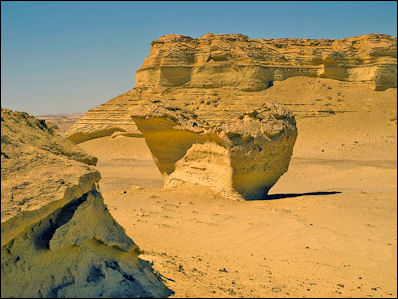
Wadi Al-Hitan Most of the fossils in the valley belong to two types: Basilosaurus was the giant, with an almost eel-like body. The more petite but heavily muscled Dorudon looked more like a modern whale, at least until its mouth opened to reveal a jaw lined with serrated daggers instead of peg-like teeth.
Far from a playground for gentle giants, prehistoric Wadi Hitan was a whale-eat-whale world.
That part of Egypt was likely a warm, nutrient-rich elongated gulf not unlike modern Baja California, where gray whales today come to bear young. Gingerich thinks that Dorudon likewise calved in the shallows, because there are unusual numbers of juvenile skeletons at the site. Some of the baby Dorudon have bite marks on their heads, likely inflicted by hungry Basilosauruses. Both whale ancestors would have feasted on other creatures in the area, which was home to sea cows, giant crocodiles, sharks and myriad other fish. Dorudon skeletons are sometimes found with jumbles of fish bones where their stomachs would have been. The Basilosaurus’ teeth are typically broken from extensive use.
The skeletons are much as they were when the first geologists found them. In death, Dorudon almost always assumed a circular posture. Basilosaurus tended to come to rest in a more or less straight line. The ocean current perhaps pushed the bodies parallel to the coast. Using the whales’ positions, scientists may one day be able to discern the shape of long-lost shores.
Tom Mueller wrote in National Geographic, “Thirty-seven million years ago, in the waters of the prehistoric Tethys Ocean, creatures died and sank to the seafloor. Over thousands of millennia a mantle of sediment built up over its bones. The sea receded, and as the former seabed became a desert, the wind began to plane away the sandstone and shale above the bones.Over several decades, Gingerich and his colleagues have located the remains of more than a thousand whales here. , and countless more are left to be discovered. [Source: Tom Mueller, National Geographic, August 2010]
U-Turn Evolution of Whales
The common ancestor of whales and of all other land animals was a flatheaded, salamander-shaped tetrapod that hauled itself out of the sea onto some muddy bank about 360 million years ago, Tom Mueller wrote in National Geographic. Its descendants gradually improved the function of their primitive lungs, morphed their lobe fins into legs, and jury-rigged their jaw joints to hear in the air instead of water. Mammals turned out to be among the most successful of these land lovers; by 60 million years ago they dominated the Earth. Whales were among a tiny handful of mammals to make an evolutionary U-turn, retrofitting their terrestrial body plan to sense, eat, move, and mate underwater. [Source: Tom Mueller, National Geographic, August 2010]
How whales accomplished such an enormous transformation has baffled even the greatest scientific intellects. Recognizing the conundrum as one of the great challenges to his theory of evolution by natural selection, Charles Darwin took a stab at accounting for whales in the first edition of Origin of Species. He noted that black bears had been seen swimming with their mouths open for hours at a time on the surface of a lake, feeding on floating insects. "I can see no difficulty in a race of bears being rendered, by natural selection, more and more aquatic in their structure and habits, with larger and larger mouths," Darwin concluded, "till a creature was produced as monstrous as a whale." His critics poked such loud and gleeful fun at this image, however, that he eventually omitted it from later editions of his book.
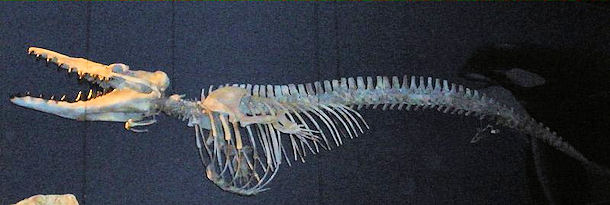
Dorudon
Finding Leg Bones of Early Whales
Tom Mueller wrote in National Geographic, “It wasn't until 1989, however, that the team found the link they were seeking to the whales' terrestrial ancestors, almost by accident. Near the end of the expedition Gingerich was working on a Basilosaurus skeleton when he uncovered the first known whale knee, on a leg positioned much farther down the animal's spinal column than he had expected. Now that the researchers knew where to look for legs, they revisited a number of previously mapped whales and rapidly uncovered a femur, a tibia and fibula, and a lump of bone that formed a whale's foot and ankle. On the last day of the expedition Smith found a complete set of slender, inch-long toes. Seeing those tiny bones brought her to tears. "Knowing that such massive, fully aquatic animals still had functional legs, feet, and toes, realizing what this meant for the evolution of whales — it was overwhelming," she remembers. [Source: Tom Mueller, National Geographic, August 2010]
Though unable to support a Basilosaurus's weight on land, these legs weren't completely vestigial. They had attachments for powerful muscles, as well as functional ankle joints and complex locking mechanisms in the knee. Gingerich speculates that they served as stimulators or guides during copulation. "It must have been hard to control what was going on down there on that long, snakelike body, so far from the brain," he says.
Whatever Basilosaurus actually did with its little legs, finding them confirmed that the ancestors of whales had once walked, trotted, and galloped on land. But the identity of these ancestors remained unclear. Certain skeletal features of archaic whales, particularly their large, triangular cheek teeth, strongly resembled those of mesonychids, a group of hoofed Eocene carnivores. (The massive, hyena-like Andrewsarchus, probably the largest carnivorous mammal that has ever lived on land, may have been a mesonychid.) In the 1950s immunologists had discovered characteristics in whale blood that suggested a descent from artiodactyls, the mammalian order that includes pigs, deer, camels, and other even-toed ungulates. By the 1990s molecular biologists studying the cetacean genetic code concluded that the whale's closest living relative was one specific ungulate, the hippopotamus.
Missing Link Between Land Animals and Whales: the Anklebone
.jpg)
Zygorhiza kochii Gingerich and many other paleontologists trusted the hard evidence of the bones more than the molecular comparisons of living animals, Tom Mueller wrote in National Geographic. They believed whales had descended from mesonychids. But to test this theory, Gingerich needed to find one bone in particular. The astragalus, or anklebone, is the most distinctive element of the artiodactyl skeleton, because it has an unusual double-pulley shape, with clearly defined grooves at the top and bottom of the bone like the grooves on a pulley wheel that holds a rope. The shape gives artiodactyls greater spring and flexibility than the single-pulley form found in other quadrupeds. (Living whales were of no help, of course, because they have no anklebones at all.) [Source: Tom Mueller, National Geographic, August 2010]
Back in Pakistan in 2000, Gingerich finally saw his first whale ankle. His graduate student Iyad Zalmout found a grooved piece of bone among the remains of a new 47-million-year-old whale, later named Artiocetus. Minutes later Pakistani geologist Munir ul-Haq found a similar bone at the same site. At first Gingerich thought the two bones were the single-pulley astragali from the animal's left and right legs — proof that he'd been right about the origin of whales. But when he held them side by side, he was troubled to see that they were slightly asymmetrical. As he pondered this, manipulating the two bones as a puzzler maneuvers two troublesome puzzle pieces, they suddenly snapped together to form a perfect double-pulley astragalus. The lab scientists had been right after all.
How Whales Evolved
Fossils from South Asia reveal that the whale’s earliest ocean-dwelling ancestors used their feet and legs to climb in and out of the water — most likely for breeding and giving birth on shore. But as time went on they relied more on tails for locomotion, the more their legs shrank. “If you’re going to be using your tail, legs get in the way,” Nick Pyenson, a curator of fossil marine mammals at the National Museum of Natural History, said. “Smaller legs reduce drag. You want to become streamlined.” Eventually whales evolved to the point where they could not return to land. By 37 million years school bus-size creatures had feet only a few centimeters (inches) long, useless for walking. Eventually, the whales’ legs would disappear altogether. [Source: Abigail Tucker, Smithsonian magazine, January 2012]
Maiacetus Tom Mueller wrote in National Geographic, “Gingerich believes the first cetaceans probably resembled anthracotheres, svelte hippo-like browsers that inhabited swampy lowlands in Eocene times. (An alternative theory, advanced by paleontologist Hans Thewissen, is that whales descended from an animal similar to Indohyus, a prehistoric deerlike artiodactyl the size of a raccoon that was partly aquatic.) Whatever their shape and size, the earliest whales appeared about 55 million years ago, like all other modern mammalian orders, during the spike in global temperatures at the beginning of the Eocene. They lived along the eastern shores of the Tethys, where the waters exerted a strong evolutionary pull: warm, salty, rich in marine life, and free of aquatic dinosaurs, which had gone extinct ten million years earlier. Chasing new kinds of food sources deeper into the water, these early waders gradually developed longer snouts and sharper teeth better suited for snapping up fish. By about 50 million years ago, they'd reached the stage exemplified by Pakicetus: proficient four-legged swimmers that still moved about on land. [Source: Tom Mueller, National Geographic, August 2010]
By adapting to water, early whales gained access to an environment closed to most other mammals, rich in food and shelter, and short on competitors and predators — perfect conditions for an evolutionary explosion. What followed was a starburst of idiosyncratic experiments in being a whale, most of which ended in extinction long before modern times. There was the hulking, 1,600-pound Ambulocetus, an ambush hunter with squat legs and huge snapping jaws, like a hairy saltwater croc; Dalanistes, with a long neck and head like a heron; and Makaracetus, with a short, curved, muscular proboscis that it may have used for eating mollusks.
Around 45 million years ago, as the advantages of a water environment drew whales farther out to sea, their necks compressed and stiffened to push more efficiently through the water, behind faces lengthening and sharpening like a ship's prow. Hind legs thickened into pistons; toes stretched and grew webbing, so they resembled enormous ducks' feet tipped with tiny hooves inherited from their ungulate ancestors. Swimming methods improved: Some whales developed thick, powerful tails, bulleting ahead with vigorous up-and-down undulations of their lower bodies. Selection pressure for this efficient style of locomotion favored longer and more flexible spinal columns. Nostrils slid back up the snout toward the crown of the head, becoming blowholes. Over time, as the animals dived deeper, their eyes began to migrate from the top toward the sides of the head, the better to see laterally in the water. And whale ears grew ever more sensitive to underwater sound, aided by pads of fat that ran in channels the length of their jaws, gathering vibrations like underwater antennae and funneling them to the middle ear.
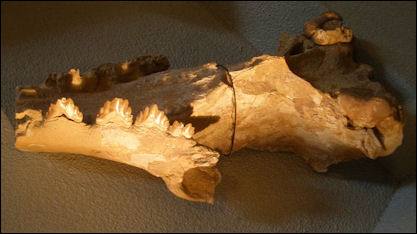
Saghacetus osiris Though finely tuned to water, these 45-million-year-old whales still had to hitch themselves ashore on webbed fingers and toes, in search of fresh water to drink, a mate, or a safe place to bear their young. But within a few million years whales had passed the point of no return: Basilosaurus, Dorudon, and their relatives never set foot on land, swimming confidently on the high seas and even crossing the Atlantic to reach the shores of what is now Peru and the southern United States. Their bodies adjusted to their exclusively aquatic lifestyle, forelimbs shortening and stiffening to serve as flippers for planing, tails broadening at the tip in horizontal flukes to create a hydrofoil. The pelvis decoupled from the spine, allowing the tail a broader range of vertical motion. Yet like talismans from a long-forgotten life ashore, their hind legs remained, complete with tiny knees, feet, ankles, and toes, useless now for walking but good perhaps for sex.
The final transition from basilosaurids to modern whales began 34 million years ago, during the sudden phase of cooling climate that ended the Eocene epoch. A drop in water temperatures near the Poles, shifts in ocean currents, and an upwelling of nutrient-rich seawater along the western shores of Africa and Europe drew whales into entirely new environmental niches and drove the remaining adaptations — big brains, echolocation, insulating blubber, and in some species, baleen in place of teeth for straining krill — present in cetaceans today.
Ancient Whale Named For "Moby Dick" Author
June 2010, AP reported: “Scientists have discovered an ancient whale whose bite ripped huge chunks of flesh out of other whales about 12 million years ago - and they've named it after the author of "Moby Dick." The prehistoric sperm whale grew about 18 meters (60 feet) long, not unusual by today's standards. But unlike modern sperm whales, Leviathan melvillei, named for Herman Melville, sported vicious, tusk-like teeth some 36 centimeters (14 inches) long. [Source: AP, June 30, 2010]
The ancient beast evidently dined on other whales, researchers said in the journal "Nature." They report finding a skull of the beast in a Peruvian desert. The researchers named it in tribute to the 19th-century author and his classic tale of the great white whale, which includes frequent digressions on natural history that punctuate the action."There is a chapter about fossils," the paper's co-author, Olivier Lambert of the Natural History Museum in Paris, said. "Melville even mentions some of the fossils that I studied for my PhD thesis."
Anthony Friscia, a paleontologist at the University of California, Los Angeles, who wasn't involved in the discovery, said scattered finds of huge fossilized teeth had long hinted at the ancient whale's existence. But without a skull to fit them in, the creature's shape, size and feeding habits remained a mystery.
"The fact that they have found the entire jaw - well, almost the entire skull - is what's pretty unprecedented," he said. The ancient beasts "were the killer whales of their time, although on a much grander scale," Friscia said. "They were close to the biggest things around." Friscia said he thought the choice of a name was fantastic. "You gotta love any time you get a nod to literature in taxonomy," he said. "It was a big whale, so why not?"
Image Source: Wikimedia Commons, NOAA
Text Sources: Animal Diversity Web (ADW) animaldiversity.org; National Oceanic and Atmospheric Administration (NOAA) noaa.gov; Wikipedia, National Geographic, Live Science, BBC, Smithsonian, New York Times, Washington Post, Los Angeles Times, The New Yorker, Reuters, Associated Press, Lonely Planet Guides and various books and other publications.
Last Updated June 2023

